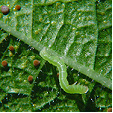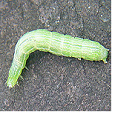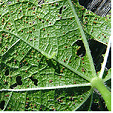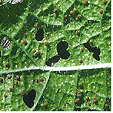Lambertia formosa



Woody
Stems and branches with a woody texture commonly associated with shrubs or perennials.
Upright-bushy
When a plant has an upright habit with intricate branching (bushy) and may have multiple stems.This shrub has an upright habit with many branches that form an open bushy crown. It has dark glossy green narrow lanced-shaped pointed leaves and the red tube-shaped flowers appear in a terminal cluster from spring to autumn.
Lambertia formosa Sm. is naturally found in New South Wales, Australia growing on the coast and the adjoining tablelands in opened eucalypt woodlands or heath from sea level to an altitude of 1000 m (3,280 ft). It prefers a very well drained poor-moderately fertile sandy-stony soil that is tending acidic, with a pH range from 5.5 to 7.0. It grows in an open sunny to semi-shaded position and is drought and mildly frost tolerant.
The Mountain Devil is grown for its bushy habit and its bright red flowers. It is planted along garden border for screening or used in large rockeries. It is also grown in tubs and planter boxes and is used in bush regeneration programmes and to attract birds. It is suitable for coastal and low-mountain regions and tolerates hot dry conditions and establishes in 2 to 3 years and is moderately long lived. This shrub has a low water requirement once established (Scale: 1-drop from 3) responding to mulch when young and reliable soil moisture, but will tolerate dry conditions.
I.D. 893
UK hardiness zone H2
Climate zones 15 - 24
USDA Zone 9-10
Lambertia (lam-BER-tee-ah) formosa (for-MOH-suh)
Etymology
Genus: - Lambertia– named after Aylmer Lambert, an 18-19th century botanist
Species: Latin - formosa - from ‘formosus’ meaning (beautiful) referring to the attractive flowers
Note:
The fruit is beaked and horned giving it a devil-like appearance.

Proteaceae (pro-tee-AY-see-ee)
Protea Family
Distribution
This family of dioecious or monoecious trees and shrubs that mainly appear in the southern hemisphere with some found in Central America and Africa. They are abundant in the southern part of Australia and normally grow on poor infertile soils that are tending acidic. Their habitats include shrubland, grassland, rainforests, alpine meadows and tropical lowlands
Diagnostic Features
The highly variable leaves are arranged alternate, opposite or whorled and are compound, dissected or lobed or pinnately toothed or simple. The margin is entire or pinnatisect and without stipules. The leaf shape can vary at different stages of growth, juvenile to adult.
The normally bisexual flowers are regular or irregular arranged in racemes or compound inflorescences (cone-like); some are solitary and appear in the leaf axils.
There are normally 4 perianth-segments that are free or united and are arranged in a single whorl, petaloid and valvate in bud joined when young and separating as the tube splits down one side.
The 4 stamens are all fertile and appear opposite the perianth segments and may be reduced to staminodes.
The filaments are partly or wholly attached to the tepals often sessile and the anthers are four chambered opening with longitudinal slits.
The ovary is superior and has one carpel that contains one chamber with one to many ovules.
The hooked style is simple and the stigma is small bulbous (capitate) or maybe bilobed.
The fruit are dehiscent or indehiscent follicle or drupe or achene with few or many winged seeds.
Note:
Some species are used for food, alcoholic drink, herbal remedies and extensively used in ornamental and domestic gardens for their fantastic flowers and foliage. There are 80 genera and 1,700 specie
This plant tolerates between USDA zones 9a to 10a and grows to 2 m (6 ft)
Fahrenheit 20º to 30º F
These temperatures represent the lowest average.
Celsius -6.6º to -1.1º C
Attention
All photographs and data are covered by copyright. Apart from any fair dealing for the purpose of private study, research, reference or review, as permitted under the Copyright Act, no part may be reproduced by any means with out written permission. All inquiries should be addressed to plantfile.com attention Peter Kirkland.

Simple
The leaf that is not divided.
Oblanceolate
A lanceolate leaf with the broadest point towards the top.
Whorled
Leaves radiate from a common part of the stem.
Recurved - Revolute
A leaf margin that is curved or bending backwards with rolled edges.
Tubulate
A flower that forms a tube shape.
Cluster or Fascicle
A general term describing flowers that are arranged in closely packed bunches.| Jan | Feb | Mar | Apr | May | Jun |
| Jul | Aug | Sep | Oct | Nov | Dec |
There are 7 sessile tubulate red flowers that are up to 50 mm (2 in) long with protruding styles and are arranged in a terminal cluster that is enclosed by reddish bracts. They are nectar rich and bird attracting and appear from spring to autumn or sporadically throughout the year.

Follicle
A capsular fruit that splits open down one side only and normally contains one seeds. "The Mountain Devil is grown for its bushy habit and its bright red flowers. It is planted along garden border for screening or used in large rockeries. It is also grown in tubs and planter boxes and is used in bush regeneration programmes and to attract birds. It is suitable for coastal and low-mountain regions and tolerates hot dry conditions and establishes in 2 to 3 years and is moderately long lived.
Sow seed when ripe in pots and maintain a temperature of 16º to 18º C (61º to 64º F), may requires scarification or pre soaking in acidic water for several hours.
Take cuttings during summer apply bottom heat.
Propagation by Seed (General)
Germination
In order for a seed to germinate it must fulfil three conditions.
1. The embryo must be alive (a viable seed).
2. The seed must have no dormancy-inducing physiological, physical or chemical barrier to germination; also the seed must be nondormant.
3. The seed must have the appropriate environmental requirements, water, temperature and oxygen.
The interaction between these requirements and dormancy is complex and may lead to different environmental requirements that avoid the dormancy of a seed.
Sowing Seeds in Containers
There are two general methods for germinating seeds.
Seeds in a flat or germinating bed, through which seedlings are pricked-out then, transplanted into another flat with wider spacing or directly to an individual pot.
2. Sowing seeds by placing them in to flats with the appropriate spacing or into individual pots.
This method is normally carried out with medium to large seeds such as woody plants and plants that are difficult to transplant.
Seedling production normally occurs in a greenhouse / glasshouse, cold frames and on hot beds.
Method of Seed Sowing
Fine seed is sown in pots or flats that are no deeper than 70 to 80 mm. using a sterilised well-drained media (soil). Fill the container to 20 mm from the top and sprinkle sieved peat to 3 mm depth.
Press the media down level and firm with a piece of timber and then thoroughly moisten.
Mix the fine seed with washed sand and then sow thinly on the surface. These may be lightly covered with sand.
Larger seeds may be covered with media or a hole is dibbled and the seed is placed in the media.
Watering Methods
For watering you may either mist the containers from above or place the container in tepid water and allow the water to raise through the pot to the surface of the media, then drain away and do not fill to the top of the container.
Place a piece of glass over the pot and store in a protected warm environment (glasshouse).
Seeds germinate best in darkness so shade the containers if in direct sunlight.
After the seedlings have sprouted remove the glass and ease the seedlings into direct light.
When the seedlings are large enough prick them out and transplant into larger containers then place them in a shade house to harden off.
Many seeds have different methods of seed preparation for germination such as nicking or cutting the seed coat to allow water penetration, also placing seeds in hot water and allowing it to cool off.
This is particularly important as it is softening the seed coat.
Asexual Propagation (Cuttings general)
Propagation from cuttings is possible because every cell of a plant containers the genetic information to create an entire plant.
1. Reproduction occurs through the formation of adventitious roots and shoots.
2. The uniting of vegetative parts with budding and grafting.
3. Taking stem cuttings and layering is possible due to the development of adventitious roots
4. Root cuttings can form new shoots then it is possible to join roots and shoots to form a new plant.
5. A new plant may be formed from a single cell in an aseptic culture system, (cloning).
It is important to propagate vegetatively as this form of cloning retains the unique characteristics of the cultivars or where particular aspects of a plant may be lost if propagated by seed.
Equipment Required for Taking Cuttings
1. A sharp knife that is not too large or a razor mounted in a handle.
2. Good pair of sharp secateurs that is clean.
3. A dibbler to make a hole in the media and allow the cutting to be placed in.
4. Propagation structures that are either a timber frame with glass or polyethylene cover or a glasshouse.
The object of the structure is to create an environment where the temperature and humidity can be controlled. This can be achieved with a simple cover over a pot with a wire frame and plastic.
This stops the draughts and maintains humidity.
5. A hotbed is a useful item as many plants root more quickly if the media is slightly warmer.
Bottom heat is obtained from thermostatically controlled heating cables that are running under the media.
6. Misting systems are of great benefit to cuttings as the regulated fogging with water inhibits the cuttings from drying out and as a result the cuttings may be grown in full sun.
This results in faster root development that is less subject to diseases by fungi and bacteria.
7. Rooting mediums
The rooting medium must be well drained, sand may be used as long as it is thoroughly washed and leached of all salts. It is very well drained and it is excellent for cutting that root up quickly. Equal parts of sand and peat moss have good results for cuttings, which are left for a period of time to allow the roots to form.
Vermiculite and perlite are also used as a well-drained rooting media but has the same disadvantage as sand having no nutrients. The cuttings must be potted up as soon as the roots developed, or a light application of liquid fertiliser can be applied.
Types of Cuttings
Stem cuttings
These are the main types of cuttings.
1. Softwood cuttings
These cuttings are taken from young growth on side shoots and tip growth.
2. Semi hardwood cuttings
These cuttings are taken from wood that is firmer and semi ripe usually during mid summer.
3. Hardwood cuttings
These cuttings are taken from mature wood normally towards the end of the season.
4. Root cuttings
Cut sections of roots to obtain new plants during late winter to early spring.
5. Leaf cuttings
Cut the leaf blade in order to obtain new plants during the growing period of the plant.
Cutting preparation
Hardwood cuttings
When taking hardwood cuttings remove the leaves and in semi hardwood reduce the number of leaves by half. Cut the wood straight across just below a node or joint. Hardwood cuttings are normally between 100 to 760 mm (30 in) long and may have either a heel of the older wood attached to the base, or a short section of the older wood at the base. These cuttings are prepared during the dormant season from late autumn to early spring and are made up from previous season's growth.
This type of cutting is used for woody deciduous plants such as Crepe Myrtle, Rose rootstocks and some fruit trees.
The cuttings should be healthy wood with ample supply of stored food as to nourish developing roots, shoots and placed in the rooting media with the aid of a dibbler stick.
Softwood cuttings
The cuttings for softwood should be 60 to 130 mm (5 1/8 in) long and be of material with enough substance as to not deteriorate before the new roots appear. Cut below a node and retain the leaves on the upper portion. Place in a well-drained media and maintain a high humidity.
Soaking the cuttings and leaving them standing in water for long periods is undesirable.
Herbaceous cuttings
These cuttings are taken from succulent plants such as Geraniums and Coleus. The cutting should be 70 to 130 mm (5 1/8 in) long with leaves retained on the upper end. As in softwood cuttings these require an environment of high humidity. Some fleshy cuttings ooze sap and may require a drying period for a few hours before being placed in the rooting media.
Leaf cutting
In these cuttings a leaf blade and petiole or part off is used to raise a new plant. The original leaf doses not become a part of the new plant as roots and shoots appear from the base of the leaf. In some cases roots appear from the severed veins.
Leaf-Bud cuttings
These cuttings incorporate a leaf, petiole and a small piece of the stem. These cuttings are an advantage where the plant uses the axillary bud at the base of the petiole for new shoot growth and maximises available propagation material, as each node will produce a new plant.
As in softwood cuttings these require an environment with high humidity and warmth.
Root cuttings
These cuttings are best taken from younger plants during late winter to early spring prior the new season's growth unless the dormant period is during summer.
Trim the roots as they are dug up, to maintain polarity cut strength at the crown end and a slanted cut at the distal end (away from the crown).
Root cuttings of small plants are placed in flats in lengths of 20 to 50 mm (2 in) and laying horizontally on the surface of the soil. These may be lightly covered with sieved sand or media, watered and then placing a piece of glass or polyethylene over the container till roots / shoots appear.
Fleshy Root cuttings
These cuttings should be 50 to 75 mm (3 in) long and placed vertically in a well-drained sand media.
Keep the polarity correct and when the roots develop transplant the cuttings into a separate container.
Large Root cuttings
These cuttings are 50 to 150 mm (6 in) long are tied up in bundles and placed in boxes of damp sand, sawdust or peat for about three weeks at a temperature of 4.5º C. When taken out they should be planted in a prepared bed 50 to 80 mm (3 1/8 in) apart with the tops of the cuttings level with or just below the soil level.
PEST
NAME
Looper Caterpillars
Various Looper Caterpillar Species
ORDER
Lepidoptera
FAMILY
Noctuidae
Description of the Pest
The looper is so-called because of the larvae's characteristic "looping" movement: the back legs move forward behind the front legs, causing the body to arch into an inverted "U" shape. They vary in colour and size; Brown Looper (Lophodes sinistraria) can grow to 50mm long, glossy black with yellowish bands then maturing to brown and found in coastal sub-tropical regions.
Green Wattle Looper (Thalaina species) adult is a small white moth with a wing span of 40mm and the lava is a slender green caterpillar with a rounded head. It is commonly found on ferny leaves Acacia species and when it is not feeding it takes up an erect position imitating a twig growing at an angle. It is difficult to detect and normally not requiring control.
Grevillea Lopper (Oenochroma vinaria) is a slender caterpillar that is greyish with orange bands and has two thorn-like projections on its back towards the head that it uses in a defence position. It is hairless with mottled orange colouring and grows to 80mm long. The adult moth (pink belly moth) has a wing span up to 60mm across and is pinkish.
Brown Looper (Lophodes sinistraria) are black with yellowish bands at first maturing to brown growing to 50mm long. It is a solitary feeder eating mature leaves and are found in tropical to sub tropical regions.
Appearance and Distribution of the Pest
Many species are found throughout Australia from tropical to temperate regions.


Life Cycle
These insects have a Holometabolous life cycle, ie. When metamorphosis is observed during the pupal stage.
Period of Activity
Most active during the warmer months the larva feed generally in the early morning or in the evening. Caterpillars are also active during cloudy days.
Damage Caused
Larvae are voracious feeders, skeletonising leaves or stripping them to the midrib preferring new growth.. Certain species feed solitary while others in groups.
The Grevillea Lopper feeds solitary or in groups defoliating small areas in species such as Lambertia and Grevillea.


Susceptible Plants
A wide range of native and exotic plants are attacked, depending on the species of looper. Plants with soft-textured foliage (eg vegetables, some indoor plants) are preferred. The Brown Looper is found on Acmena smithii, Waterhousea floribunda and Macadamia species.
Tropaeolum and Calendula species are attacked by the Cabbage Looper (Trichoplusia ni), which feeds on the leaves and flowers.Tropaeolum species are also attacked by the caterpillar (Pieris rapae), which eats the foliage.
Cultural Control
Small numbers may be removed by hand.
Biological Control
Birds and other predators reduce numbers.
Chemical Control
The plant may be sprayed using Carbaryl. During heavy infestations this method is effective.
Note
Always read the label for registration details and direction of use prior to application of any chemicals.
Average Lowest Temperature : -3º C 27º F
USDA : 9, 10
This USDA (United States Department of Agriculture) hardiness zone chart can be used to indicate a plant’s ability to withstand average minimum temperatures. However, other factors such as soil type, pH, and moisture, drainage, humidity and exposure to sun and wind will also have a direct effect on your plant’s survival. Use this chart only as a guide, always keep the other factors in mind when deciding where, when and what to plant.
A plant's individual USDA zone can be found in the Plant Overview.
Climate Description
Warm Temperate
This zone has the majority of rain during winter in the west and summer in the east with high humidity. Summer temperatures may peak at 40ºC (104ºF).
Frost and drought mainly occur inland and coastal wind is normally accompanied with rain.
Plant growth
Wide range of native and exotic plants grow well.
| Dictionary | Growth Habit |
| Leaf Type | Botanic Flower Description |
| Leaf Shape | Flower Inflorescence |
| Leaf Arrangement | Fruit Type |
| Leaf Margin | Bark Type |
| Leaf Apex And Bases | Flower Description |